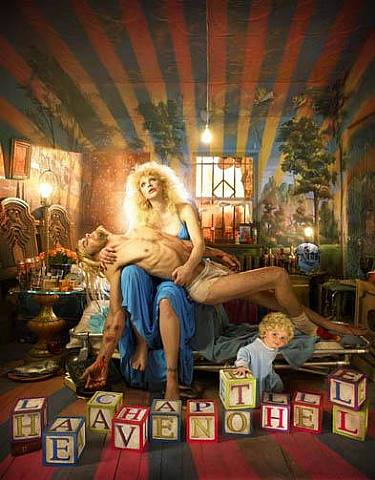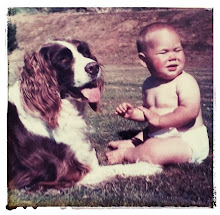Fiona Meadley
She is curating an exhibition called 'Ghosts in the Attic' in the old house, now a museum, that once belonged to Edward Jenner (famous for the smallpox vaccine). She mentions Freud wrote that the "attic is the subconscious of the mind" and in this previously unseen part of the house, her exhibition as artist-in-residence aims to suggest Jenner's 'ghosts'. These are people who died from smallpox but also perhaps flowing from hallucinations that he experienced as a child. When Jenner was variolated (purposely infected with the smallpox disease in an attempt to protect against future infections) he was isolated in the attic of his house for a month. She mentioned Tacita Dean and the book Immunology by A. David Napier. I was interested in the screenshot of a film by Maya Deren called 'Meshes of the Afternoon' and having watched half of it I can see why it is an inspiration- it is dreamy, mysterious and obscure.
Sue Bovington
Found the artists' work Sue showed very engaging, all relating to maps: Peter Greenaway, 'A Walk Through H' is utilises extraordinary maps; Kathy Prendergast's 'Erased Maps' where she has chosen a section of a map and erased everything ex
 cept a certain word, ie Lost, I found fascinating. Sue also mentioned a work called 'City Drawings' look and sound interesting but I cannot find an image large to study in any depth. I also liked the idea of Clare Bryan's 'Cut Out Maps' and the photos looked brilliant. Lastly she talked about David Nash whom I love after his work being suggested to me during 2nd year of my BA and then catching an exhibition of his work at the Tate St. Ives it captivated me. I saw his 'Pyramid, Sphere & Cube' (left). His unicorn horn and boulder that moved down a stream were good too.
cept a certain word, ie Lost, I found fascinating. Sue also mentioned a work called 'City Drawings' look and sound interesting but I cannot find an image large to study in any depth. I also liked the idea of Clare Bryan's 'Cut Out Maps' and the photos looked brilliant. Lastly she talked about David Nash whom I love after his work being suggested to me during 2nd year of my BA and then catching an exhibition of his work at the Tate St. Ives it captivated me. I saw his 'Pyramid, Sphere & Cube' (left). His unicorn horn and boulder that moved down a stream were good too.Jo Russell
Graphic Design MA student who works for Wiltshire College. Also David Mckean. Mentions Egon Schiele/Svankmajer/Quay Bros. What interested me most was Takashi Murakami's work- I had admired Kanya West's album cover but didn't know who it was, and had found a Murakami piece (featuring a character called 'Mr Dob', so Jo told me) in Dazed&Confused magazine but didn't realise how massive he is.

She also mentioned Andrea Canalito and in particular a piece which features plastic deer heads coming out of saccharine-looking plastic cupcakes. It's obvious that humour and colour are central to Jo's interests, and also texture- she seems to like plastic. I think it was Jo who also talked about Saul Bass- I was aware of the style in
Hakima al Siad
She showed first tattoos by the American tattoo artist and star of TV shows, Kat von D. Having watched Miami Ink I was aware of her work but never really considered her an artist before- now I don't see why she should not be considered an artist. Her work is execute
 d with amazing attention to detail and whereas other artists can work when or how they please, the limits of tattooing a person's skin places creative constraints. Kat von D is known for portraits. I recently discovered another tattooist/artist called Angelique Houtkamp who has a distinctive Sailor Jerry/50s style.
d with amazing attention to detail and whereas other artists can work when or how they please, the limits of tattooing a person's skin places creative constraints. Kat von D is known for portraits. I recently discovered another tattooist/artist called Angelique Houtkamp who has a distinctive Sailor Jerry/50s style. Hakima talked about David LaChapelle, a photographer famous particularly for celebrity images. He created the eponymous image of the rap star Lil' Kim covered in Louis Viutton logos to present her as an expensive item. He also set up a photograph of Courtney Love holding a model (LaChapelle's boyfriend) posed as Kurt Cobain- an amazing piece that is so ludicrously detailed it looks like a painting.
Hakima talked about David LaChapelle, a photographer famous particularly for celebrity images. He created the eponymous image of the rap star Lil' Kim covered in Louis Viutton logos to present her as an expensive item. He also set up a photograph of Courtney Love holding a model (LaChapelle's boyfriend) posed as Kurt Cobain- an amazing piece that is so ludicrously detailed it looks like a painting.She showed some work by a Muslim artist with whom she identifies, and spoke about caligraphy & Arabic, combined with Muslim culture and feminism.
John Cummings
None of John's artists were visual artists- he first talked about Bill Bryson's book, A Short History of Nearly Everything (one of the most brilliant books I have ever read; however I couldn't quite make it to the end- I still plan to). John seems particularly interested in Bryson's presentation of heavy and complex science in a simple and accessible manner. He also talked about, and showed some of, Al Gore's An Inconvenient Truth lecture. John appreciates Gore's representation in graphs of something that is otherwise difficult to fully comprehend and is attracted to something called action research- where the researcher takes part in, and influences, the subject area they are researching. He would like to start a charity to educate people about their relationship with the environment, to encourage people to be aspirational about it, rather than imposing penalties, by giving away seeds and information, for example. Fiona commented that by being tied down with all the detritus that running a charity entails he may find it more frustrating that productive.
Maia Conran
Talked about Mark Leckey's Turner Prize entry, which I happened to see but not really understand (good article at the Guardian Online). She is interested in the evolution of Leckey's lecture, and that of her own (although the fact that the entry for the Turner Prize is recorded means it is set and cannot change). She spoke about Edward Rucsha, a photographer who is famous for photographing 26 gas stations and the same stretch of Venice Beach for years. I really liked his gas station photographs- very architectural, detached and calm, and apparently free of human emotion.

She also experimented during her presentation with showing her artist statement instead of her artwork- investigating the validity of presenting a piece of art instead of a dissertation.

No comments:
Post a Comment